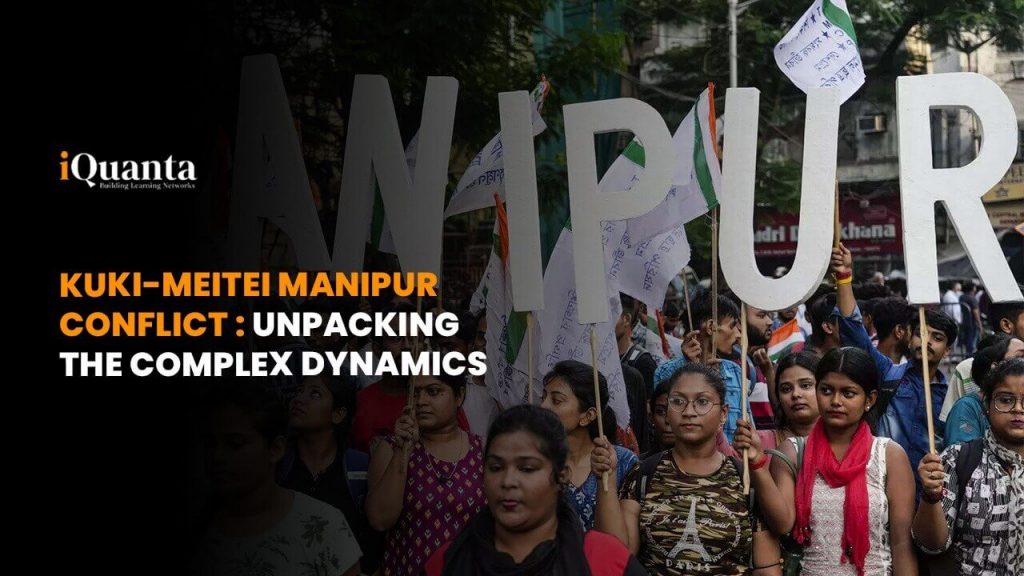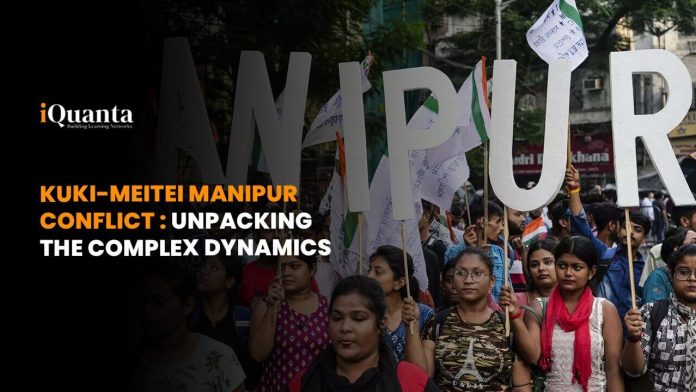
Genre : Current Affairs/ Socio-Political
The mention of Manipur in ancient texts like the Mahabharata, where Arjuna was enchanted by the beauty of Princess Chitrangada, evokes an image of a land with a rich history. Today, Manipur finds itself embroiled in a cycle of insurgency, ethnic tensions, and internal discord, accounting for a staggering 47% of insurgency-related violence in India’s Northeast region. This article delves deep into the multifaceted Kuki-Meitei conflict in Manipur, examining its historical roots, geographical challenges, and the intricate web of ethnic rivalries that continue to plague the state.
Manipur, often regarded as “The Bejeweled Land,” has remained one of the most troubled states in India’s Northeast. A striking 47% of the insurgency-related violence in the region is concentrated in Manipur. This unrelenting cycle of unrest has not only hindered the state’s economic development but has also sown the seeds of ethnic strife and intra-state dissonance. The primary obstacle to development in Manipur is the persistent hill-valley divide, which is exacerbated by periodic economic blockades engineered by various ethnic groups. Additionally, insurgents operate a parallel economy, further exacerbating the economic challenges.

Despite increased financial allocations from New Delhi, Manipur’s economy has failed to show significant signs of improvement. Reports suggest that only a fraction of government expenditure is directed towards development, with the remainder allegedly being siphoned off by various illicit forces and insurgents. Manipur’s fortunes have predominantly been tied to military strategies deployed against an array of insurgencies that have found refuge across the border in Myanmar. Unfortunately, despite these efforts, Manipur remains resistant to counterinsurgency interventions, trapping the state in a vicious cycle of violence.
The Legislative Spark & Its Aftermath
Civil strife has once again erupted in Manipur, this time ignited by a legislative bill. The Manipur (Hill Areas) Autonomous District Council Bill 2021 was anticipated to grant the hill communities enhanced financial and administrative autonomy, potentially bridging the divide with the Valley. However, discontent arose when the government introduced the Manipur (Hill Areas) District Council 6th and 7th Amendment bills instead. This sparked protests from the Kuki community and others. In response, the All-Tribal Students’ Union Manipur (ATSUM) imposed an indefinite economic blockade along the national highways in the hill districts. The Meiteis in the Valley retaliated by blockading the hill districts. In an effort to prevent further escalation, the state administration severed internet and mobile network connections across Manipur. Talks of a compromise, including the release of arrested ATSUM leaders and a review of the Manipur (Hill Areas) Autonomous District Council Bill 2021, are underway, but the economic blockade continues to inflict untold suffering on the common people of the state.
The geographical configuration of Manipur also, if not mostly – plays a pivotal role in fueling conflict, magnifying the chasm between the Valley and the Hills. Manipur’s total area covers 22,347 square kilometers, divided into Hills and a Valley. The Valley, encompassing a mere 10.02% of the total area, is home to 58.85% of the state’s population. The Meiteis, a non-tribal group primarily inhabiting the Valley, constitute the largest ethnic community in the state. In contrast, the hills are the abode of the Nagas and the Kukis, along with their 29 sub-tribes. Additionally, Manipur has a Muslim community known as Pangals, mainly immigrants from pre-partition East Bengal, East Pakistan, and present-day Bangladesh, residing in the Valley. This group forms approximately 8% of the state’s population. The remaining non-tribal population, referred to as Mayang (outsiders), hail from various parts of the country.
Ethnic Divisions and Cultural Fragmentation
The ethnic diversity within Manipur has resulted in a fragmented social fabric. Different ethnic groups maintain distinct identities, lacking a common Manipuri identity that could foster harmonious coexistence. This phenomenon extends beyond Manipur and has become a broader issue in the Northeast, where ethnic groups assert their identities and seek separate statuses.
Historical Legacies – the bad blood between the Kuki and the Meiteis
The historical backdrop of Manipur is rife with complexities and unresolved grievances. Prior to British annexation in 1891, Manipur existed as a principality. However, colonial rulers retained its princely state status under British dominion, employing divisive tactics. Christian missionaries arrived in Manipur in 1894, gradually converting animistic tribes to Christianity through the provision of essential services like medical aid and education. In the 1901 Census, Christians comprised only 8% of the population, while Hindus accounted for 60%. By 1991, the number of Christians in Manipur had surged to 34.11%, significantly widening the socio-cultural divide between the Hindu Meiteis of the Valley and the Christian tribes of the Hills. This religious and cultural schism has evolved into a permanent source of socio-political rivalry.
A Precarious Situation and Impending Crisis
The current state of Manipur is alarming, demanding immediate attention from New Delhi. Recent internecine strife between the Meiteis and the Kukis serves as a stark warning. Moreover, the looming presence of the National Socialist Council of Nagaland (Isak-Muivah) (NSCN-IM) over Naga-inhabited areas of Manipur has heightened Meitei apprehensions that the passage of the Manipur (Hill Areas) Autonomous District Council Bill 2021 could pave the way for the balkanization of the state. Manipur’s fault lines are numerous, providing fertile ground for inimical foreign powers. With Myanmar’s uncertain disposition and its harboring of numerous insurgents, the stage could be set for Chinese intervention.
The Path Forward
A comprehensive strategy is urgently required to address Manipur’s myriad challenges. Establishing a task force to thoroughly investigate the overarching issues plaguing Manipur, including the possibility of granting Scheduled Tribe (ST) status to the Meiteis, could help mitigate community concerns. In conclusion, Manipur, despite its geographical and ethnic complexities, remains a land of immense potential. Collaborative efforts are essential to bridge divides, redress historical grievances, and foster unity among its diverse communities. Only then can Manipur truly shine as the “bejeweled land” it was destined to be, where the Sangai, the dancing deer in Keibul Lamjao, can prance in delight once more…
If any of the exams you’re preparing for concerns General Awareness (MBA, UPSC, GDPI, etc.), you can go for iQuanta’s GK Course.


